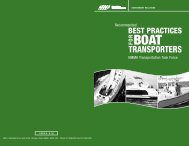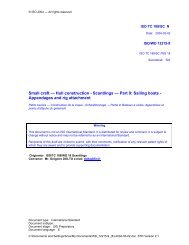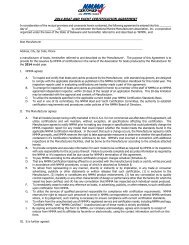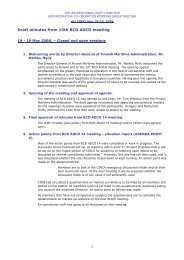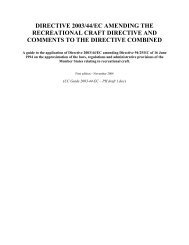global environmental legislation guide - National Marine ...
global environmental legislation guide - National Marine ...
global environmental legislation guide - National Marine ...
Create successful ePaper yourself
Turn your PDF publications into a flip-book with our unique Google optimized e-Paper software.
Implementation of an effective bio fouling management regime is critical for minimizing thetransfer of invasive aquatic species. The bio fouling management measures to beundertaken on a ship should be outlined in a bio fouling management plan and records ofbio fouling management practices kept in a bio fouling record book.Focus on commercial vessels and superyachtsThe <strong>guide</strong>lines should focus on commercial vessels and recreational vessels greater than 24metres in length (superyachts). Guidance for small recreational craft of less than 24 metresin length should be developed as a stand-alone document. The two documents shouldcontain appropriate cross references.The <strong>guide</strong>lines including a set of the “bio fouling management plan” and “bio foulingrecord book” for superyacht and recreational craft (less than 24 meters) will be separatelyforwarded to MIAs.E. IMO MARPOL 73/78 ANNEX VI: Prevention of air pollution from shipsThe International Maritime Organisation (IMO) is an agency of the United Nations; itsMARPOL convention, originally settled in 1973 and 1978, addresses limits for emissions ofsulphur (SOx) and nitrogen oxide (NOx) (adopted in the 1997 protocol – annex VI). The 2008amendments to annex VI set further limits and apply both <strong>global</strong>ly and in dedicated emissioncontrol areas (ECAs), both for sulphur and nitrogen oxide 1 . Coming into force on 1 July 2010,the revised annex VI allows for an emission control area to be designated for SOx andparticulate matter, or NOx, or all two types of emissions from ships.The main changes to MARPOL annex VI will see a progressive reduction in sulphur oxideemissions from ships, with the <strong>global</strong> sulphur cap reduced initially to 3.50% (from thecurrent 4.50%), effective as of 1 January 2012; then progressively to 0.50 %, effective from 1January 2020, subject to a feasibility review to be completed no later than 2018. The limitsapplicable in Sulphur Emission Control Areas (SECAs) were reduced to 1.00% on 1 July 2010and will be further reduced to 0.10 %, in 2015.Progressive reductions in nitrogen oxide (NOx) emissions from marine engines were alsoagreed. NOx emission limits are set in MARPOL annex VI for diesel engines depending on theengine maximum operating speed (n, rpm), as shown in Table 1 and presented graphically inFigure 1.Tier I and Tier II limits are <strong>global</strong>, while the Tier III standards apply only in NOx emissioncontrol areas.Table 1. MARPOL Annex VI NOx Emission LimitsTier Date NOx Limit, g/kWhn < 130 130 ≤ n < 2000 n ≥ 20001 Current ECAs include the Baltic Sea (SOx, adopted: 1997/entered into force: 2005), North Sea (SOx,2005/2006), North American ECA, including most of US and Canadian coast (NOx & SOx, 2010/2012).36



